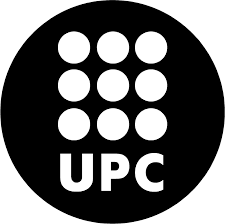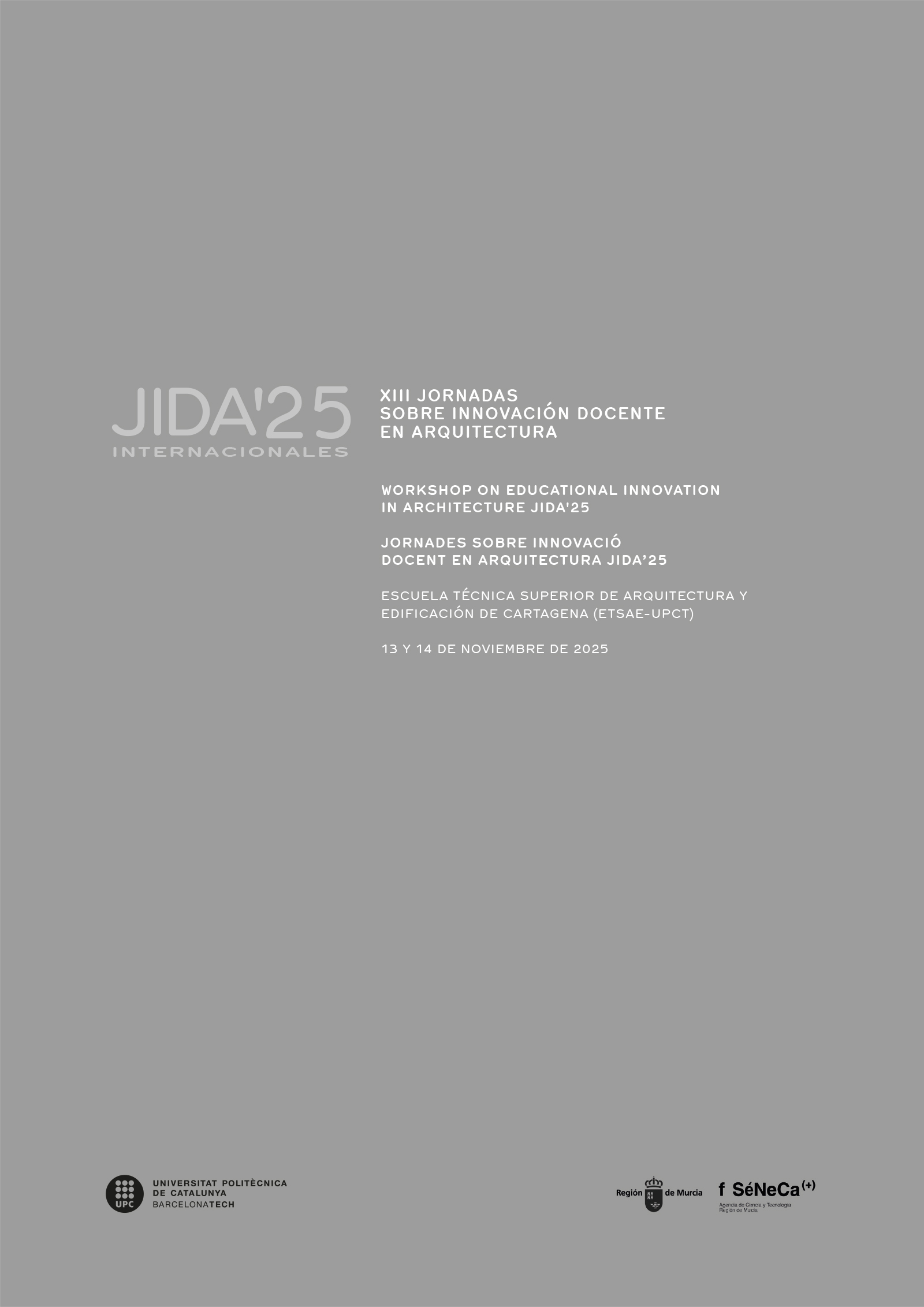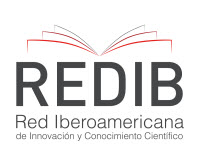Child’s Play: a pedagogical model for the first semester of architecture
DOI:
https://doi.org/10.5821/jida.2025.13690Keywords:
embodied knowledge, experiential learning, children’s play, architectural education, community validationAbstract
The paper presents Childhood Games, a pedagogical model for the first semester of architecture that seeks to overcome traditional propaedeutic teaching, usually based on abstract exercises disconnected from bodily experience. The model draws on embodied and situated pedagogies, activating creativity through intuition by means of memory, collective construction, and full-scale verification. The methodology consists of three phases: memory-game (autobiographical evocation through drawing and narrative), built-game (collective construction of a 1:1 play structure validated by the community), and project-game (individual projection). The experience, involving 30 students over five months, was evaluated using the Experiential Learning Survey (ELS). Results show a high overall assessment (α=0.97), reinforced by observing children’s interaction with the constructed works. Some groups highlighted usefulness and future projection, while others emphasized process and personal reflection. This exploratory study shows that the model fosters the early activation of architectural thinking through sensitive, collective, and verifiable experiences.
References
Al Borde. Proyectos / Projects. Quito, Ecuador: Al Borde. s.f. https://www.albordearq.com/ (consultado el 15 de septiembre de 2025).
Awan, Nishat., Tatjana. Schneider, and Jeremy. Till. 2011. Spatial Agency : Other Ways of Doing Architecture. Routledge.
Babb, Kathryn, and Laurie Campbell. 2023. “Counselors in Training Value of Experiential Learning Experiences: An Exploratory Analysis.” Experiential Learning and Teaching in Higher Education 6 (1-March): 67–78. https://doi.org/10.46787/ELTHE.V6I1.3593.
Bizzotto, Lucas. 2022. “Cognición Encarnada. El Dibujo Sensible Como Técnica de Reconocimiento Del Espacio Arquitectónico.” Estoa 11 (22): 83–93. https://doi.org/10.18537/est.v011.n022.a07.
Chan, Eddie. 2020. “An Education of Intuition and Process: Learning Architectural Design at Hong Kong Design Institute.” Cubic Journal 3: 166–81. https://doi.org/10.31182/CUBIC.2020.3.030.
Clem, Jamie M., Annelise M. Mennicke, and Christina Beasley. 2014. “Development and Validation of the Experiential Learning Survey.” Journal of Social Work Education 50 (3): 490–506. https://doi.org/10.1080/10437797.2014.917900.
Danko, Tiffany. 2019. “Student Perceptions in Homeland Security and Emergency Management Education: Experiential Learning Survey.” Journal of Experiential Education 42 (4): 417–27. https://doi.org/10.1177/1053825919873678.
Dewey, John. 1980. Art as Experience. 23rd ed. New York: Perigee Books.
Dewey, John. 1976. Experience & Education. 99th ed. New York: Collier Books.
Equipo Mazzanti. Espacios sociales para el aprendizaje. ArchDaily. 16 de agosto de 2019. https://www.archdaily.cl/cl/923168/el-equipo-mazzanti-espacios-sociales-para-el-aprendizaje (consultado el 15 de septiembre de 2025).
Escuela de Arquitectura, Universidad de Talca. s.f. Repositorio Obras de Título. https://www.obrasdetitulo.cl/project (consultado el 15 de septiembre de 2025).
Feniger-Schaal, Rinat, Tobias Constien, and Hod Orkibi. 2024. “Playfulness in Times of Extreme Adverse Conditions: A Theoretical Model and Case Illustrations.” Humanities and Social Sciences Communications 11 (1): 1–10. https://doi.org/10.1057/S41599-024-03936-Z;SUBJMETA.
Freire, Paulo. 2005. Pedagogía Del Oprimido. Translated by Jorge Mellado. 55th ed. Tucuman: Siglo XXI Editores.
Garvey, Catherine. 1985. El Juego Infantil. Cuarta edición. Madrid: Ediciones Morata.
Green, Shawn Lourens, and Elizabeth Catharina (Elize) du Plessis. 2023. “Project-Based Learning to Promote Learner Autonomy in Training Hospitality Education at a Technical and Vocational Education and Training College.” International Journal of Learning, Teaching and Educational Research 22 (7): 136–55. https://doi.org/10.26803/ijlter.22.7.8.
Han, Byung-Chul. 2010. La Sociedad Del Cansancio. Translated by Arantzazu Saratxaga Arregi. Barcelona: Herder.
Haraway, Donna Jeanne. 1995. Ciencia, Cyborgs y Mujeres : La Reinvención de La Naturaleza. Valencia: Cátedra.
Hefley, William E, and Mark F Thouin. 2016. “Evaluation of Experiential Learning in Scrum and Agile Project Management.” AMCIS 2016 Proceedings, August. https://aisel.aisnet.org/amcis2016/ISEdu/Presentations/36.
hooks, bell. 1994. Teaching Transgress. Education as the Practice of Freedom. New York: Routledge.
Hossain, Shaukat Ali, Mehmood Ahmed Manzoor, and Rozina Hashmi. 2023. “Experiential Learning to Promote Student Autonomy at Elementary Level.” Journal of Innovation and Research in Primary Education 2 (1): 1–6. https://doi.org/10.56916/JIRPE.V2I1.356.
Huizinga, Johan. 2007. Homo Ludens. Translated by Eugenio Imaz. 6th ed. Madrid: Alianza Editorial.
Ingold, Tim. 2013. Making: Anthropology, Archaeology, Art and Architecture. New York: Routledge.
Kamal, Aliaa M., Hisham S. Gabr, and Mennat Allah El-Husseiny. 2024. “Assessing Child-Play Environments: Architectural Impact of Nature Based Play-Areas on the Quality of Children’s Development.” New Design Ideas 8 (1): 184–206. https://doi.org/10.62476/NDI81184.
Khan, Najmonnisa, and Lubna Oad. 2020. “Promoting Learners’ Autonomy at Elementary Level through Experiential Learning: A Quantitative Study,” July. https://www.prdb.pk/front/promoting-learners-autonomy-at-elementary-level-through-e-2391.
Kounios, John, and Mark Beeman. 2009. “The Aha! Moment: The Cognitive Neuroscience of Insight.” Current Directions in Psychological Science 18 (4): 210–16. https://doi.org/10.1111/J.1467-8721.2009.01638.X.
Larrivee, Shaina D. 2011. “Playscapes: Isamu Noguchi’s Designs for Play.” Public Art Dialogue 1 (1): 53–80. https://doi.org/10.1080/21502552.2011.536711.
Lee, Jin Mi. 2025. “Embodied Learning in Architecture: A Design Studio Model Utilizing Extended Reality †.” Buildings 15 (13): 2158. https://doi.org/10.3390/BUILDINGS15132158/S1.
Merleau-Ponty, Maurice. 1994. Fenomenología de La Percepción. Translated by Jem Cabanes. Planeta-Agostini. Barcelona: Editorial Planeta-De Agostini.
Matook, Sabine, Yazhu Maggie Wang, and Micheal Axelsen. 2025. “Experiential Learning for Citizen Developers: Training IT Talent in Low-Code Development and Metacognitive Reflection.” Business and Information Systems Engineering 67 (1): 7–30. https://doi.org/10.1007/S12599-024-00921-3/FIGURES/5.
Maturana, Humberto, y Francisco Varela. 2011. El Árbol Del Conocimiento: Las Bases Biológicas Del Entendimiento Humano. Fuera de Serie. Vol. 2. Editorial Universitaria.
Mazzarotto, Marco, and Bibiana Serpa. 2022. “(Anti)Dialogical Reflection Cards: Politicizing Design Education through Paulo Freire’s Critical Pedagogy.” DRS2022: Bilbao, June. https://doi.org/10.21606/DRS.2022.710.
Meyer, Jan H F, and Ray Land. 2003. “Threshold Concepts and Troublesome Knowledge: Linkages to Ways of Thinking and Practising within the Disciplines.” In Improving Student Learning – Ten Years On, edited by Chris Rust. Oxford Centre for Staff and Learning Development (OCSLD).
Mistral, Gabriela. 1924. “Ternura (1924 y 1945).” Memoria Chilena, Biblioteca Nacional de Chile. Accessed September 14, 2025. https://www.memoriachilena.gob.cl/602/w3-article-100846.html.
NTNU – Norwegian University of Science and Technology. NTNU Live Studio: Projects in the Real World. Faculty of Architecture & Design. s.f. https://www.ntnu.edu/ad/live-studio (consultado el 15 de septiembre de 2025).
Pallasmaa, Juhani. 2006. Los ojos de la piel: La arquitectura y los sentidos. Barcelona: Editorial Gustavo Gili.
Pez Arquitectos & Chiquitectos. Proyecto MICOS: Entornos Escolares Saludables. Madrid: Pez Arquitectos / Chiquitectos. s.f. https://www.pezarquitectos.com/micos/ (consultado el 15 de septiembre de 2025).
Red OCARA. Experiencias y Proyectos: Ciudad, Arquitectura y Niñez. s.f. https://www.redocara.com/ (consultado el 15 de septiembre de 2025).
Rural Studio. Educating Citizen Architects. s.f. Rural Studio. https://ruralstudio.org/ (consultado el 15 de septiembre de 2025).
Salama, Ashraf M., and Lindy Osborne Burton. 2022. “Defying a Legacy or an Evolving Process? A Post-Pandemic Architectural Design Pedagogy.” Proceedings of the Institution of Civil Engineers: Urban Design and Planning 175 (1): 5–21. https://doi.org/10.1680/jurdp.21.00023.
Schön, Donald. 1992. La Formación de Profesionales. Hacia Un Nuevo Diseño de La Enseñanza y El Aprendizaje Las Profesiones. Barcelona: Ediciones Paidós.
Taller A77, FADU-UBA. Proyectos del Taller A77. Facultad de Arquitectura, Diseño y Urbanismo, Universidad de Buenos Aires. s.f. https://expo.fadu.uba.ar/taller-a77/ (consultado 15 de septiembre de 2025).
Tohit, Eusni Rahayu Binti Mohd, Fauzah A. Ghani, Hizmawati Madzin, Intan N. Samsudin, Subashini C. Thambiah, Siti Z. Zakariah, and Zainina Seman. 2022. “Experiential Learning in Clinical Pathology Using Design Thinking Skills (DTS) Approach.” Asia Pacific Scholar 7 (4): 76–82. https://doi.org/10.29060/TAPS.2022-7-4/CS2780.
Thouin, Mark F., and William E. Hefley. 2024. “Teaching Tip: Teaching Scrum Product Owner Competencies Using an Experiential Learning Simulation.” Journal of Information Systems Education 35 (1): 37–47. https://doi.org/10.62273/GXMA1727.
TU Delft. Architecture & the Built Environment: Student Projects. s.f. https://www.tudelft.nl/en/architecture-and-the-built-environment/study/student-projects (consultado el 15 de septiembre de 2025).
Yale School of Architecture. The Jim Vlock First Year Building Project. Yale School of Architecture. s.f. https://www.architecture.yale.edu/academics/building-project (consultado el 15 de septiembre de 2025).
Varela, Francisco, Eva Thompson, and Eleanor Rosch. 1992. De Cuerpo Presente. Las Ciencias Cognitivas y La Experiencia Humana. 1a edición. Barcelona: Editorial Gedisa S.A.
Vigotsky, Lev. 1986. La Imaginación y El Arte La Infancia. Ensayo Psicológico. Madrid: Akal.
Wang, Shuaizhong. 2024. “Structural Design Pedagogy under the Embodied Perception: An Equilibrium-Based Approach for Architecture Students.” In Proceedings of the IASS 2024 Symposium. Redefining the Art of Structural Design, edited by P Block, G Boller, C DeWolf, J Pauli, and W Kaufmann, 26–30. Zurich. https://www.ingentaconnect.com/contentone/iass/piass/2024/00002024/00000016/art00003;jsessionid=7dj7bld33mbiq.x-ic-live-01#Supp.
Winnicott, D. W. 2003. Realidad y Juego. Translated by Floreal. Mazía. Barcelona: Editorial Gedisa.
Withagen, Rob, and Simone R. Caljouw. 2017. “Aldo van Eyck’s Playgrounds: Aesthetics, Affordances, and Creativity.” Frontiers in Psychology 8 (JUL). https://doi.org/10.3389/fpsyg.2017.01130.






















